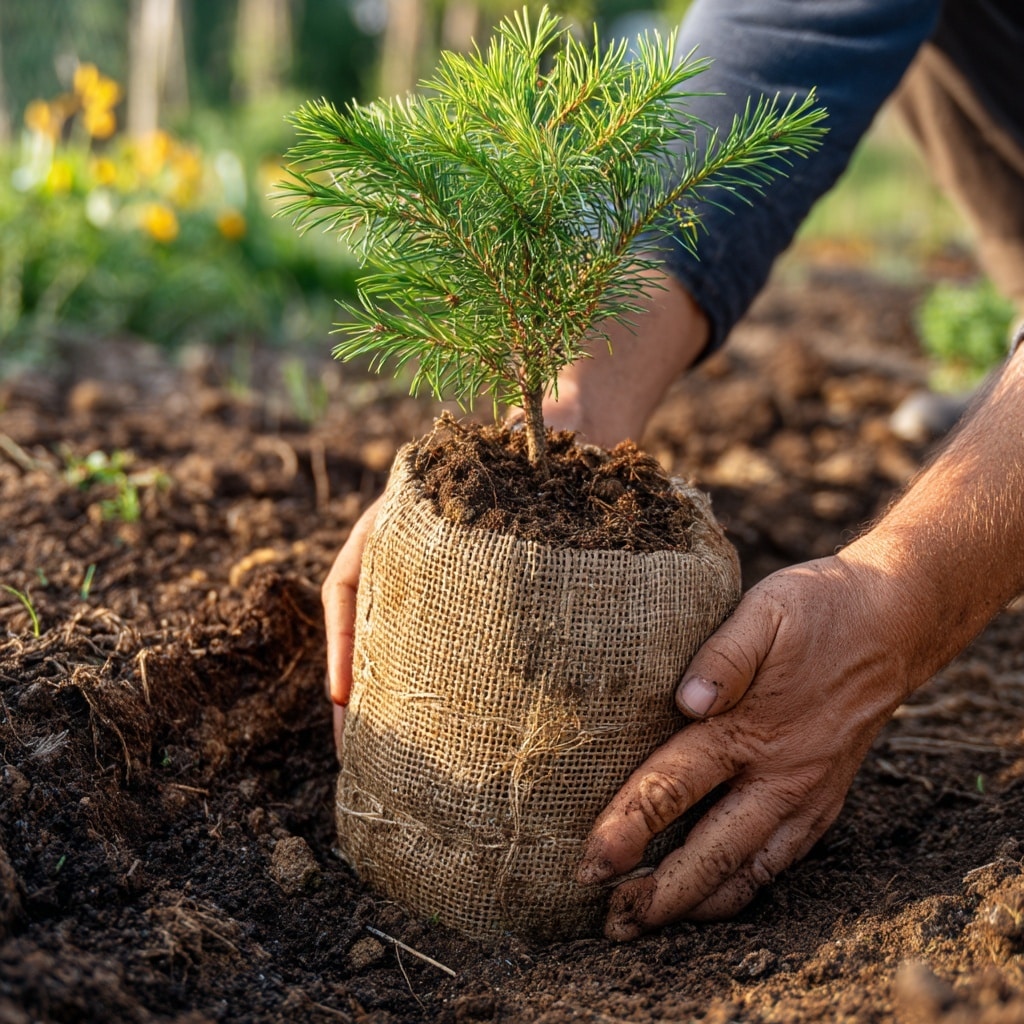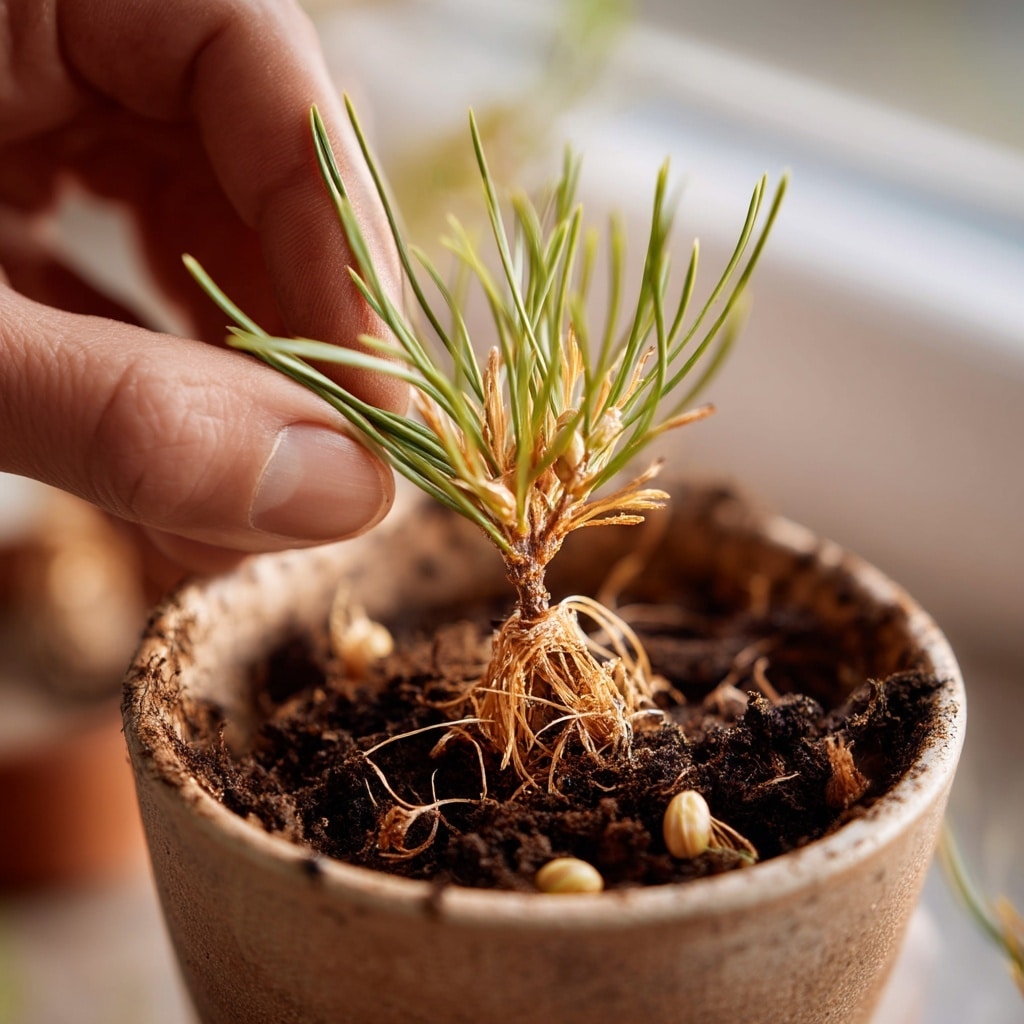Pine tree planting is one of the most rewarding projects for any gardener or homeowner looking to add lasting greenery to their landscape. Whether you’re starting from seed or transplanting a young sapling, growing a pine tree can be a simple, satisfying process when done with care and attention.
In this guide, we’ll walk through two proven methods—growing from seed and planting saplings—so you can choose the one that suits your timeline, goals, and climate. With the right techniques and a little patience, your pine tree will thrive for decades to come.
Table of Contents
How to Grow a Pine Tree from Seed
Starting a pine tree from seed is a slow but deeply rewarding process, perfect for those who enjoy watching life unfold from the very beginning. While it takes patience, growing from seed allows you to cultivate a strong root system and a tree that’s well-adapted to your environment.
Step 1: Collect Viable Pine Seeds
Begin by harvesting mature pinecones from healthy trees in your region. Choose cones that have opened naturally, as these are more likely to contain mature seeds. Turn the cones upside down and gently shake them to release the seeds.
Step 2: Test for Germination Potential
Fill a small container with water and drop the seeds in. Discard any that sink to the bottom—these typically lack viable embryos. Only keep the seeds that float on the surface.
Step 3: Store Seeds Before Planting
Allow your seeds to dry completely. Then place them in an airtight container and store them in a cool, dark place until you’re ready to plant. For most climates, late December to early January is an ideal time to begin.
Step 4: Prepare the Planting Container
Use a small pot filled with nutrient-rich, well-draining soil. Water the soil lightly to moisten it before placing the seed.
Step 5: Plant the Seed Properly
Place the seed just below the surface, vertically, with the pointed end facing downward. This orientation supports natural root growth and helps with stem development.
Step 6: Provide Sunlight and Regular Watering
Position the pot near a sunny window, and water regularly to keep the soil moist—but not soggy. Be patient. Germination won’t occur immediately. It can take until March or April to see signs of life.
Step 7: Watch for Pine Needles
When the pine needles start to emerge, rotate the pot every few days. This encourages straight growth and prevents the seedling from leaning toward the light source.
Step 8: Transplant to a Larger Pot
Once your pine tree seedling reaches 6–12 inches (15–30 cm) in height, transplant it into a 1-gallon pot. Move it outdoors to begin acclimating it to your local climate.
Step 9: Final Outdoor Planting
When the young tree outgrows its pot or reaches 12–18 inches in height, it’s ready for its permanent spot. Choose a sunny location with well-drained soil and protect it from strong winds during its first year.
How to Plant a Pine Tree from a Sapling

Planting a young pine tree sapling is a quicker way to enjoy the beauty and benefits of this evergreen. Whether you’ve bought your sapling from a nursery or received it through a conservation program, proper planting ensures healthy growth and long-term success.
Step 1: Unwrap the Root Ball Carefully
Most saplings come with their roots wrapped in burlap and secured in a ball of soil. Handle this part of the tree gently, always lifting it by the root ball, not the trunk. This prevents stress or damage to the young tree’s structure.
Step 2: Dig a Proper Planting Hole
Dig a hole that is twice as wide as the root ball and just as deep—no deeper. A wide hole encourages root expansion, while the correct depth ensures the trunk base stays at soil level.
Step 3: Place the Tree and Position It Upright
Lower the root ball into the center of the hole, ensuring the tree is upright and centered. Have someone hold the pine tree steady while you begin backfilling.
Step 4: Fill the Hole and Avoid Overpacking
Refill the hole with native soil, lightly pressing down to remove air pockets. Do not compact the soil too firmly—loose soil allows water to drain efficiently and roots to spread easily.
Step 5: Water Thoroughly After Planting
Give the sapling a deep watering immediately after planting. This helps settle the soil and supports early root establishment. Continue watering once or twice a week during the first year, especially in dry periods.
A properly planted sapling can begin establishing roots quickly and will reward you with steady growth for years to come.
Caring for Your Pine Tree After Planting

Once your pine tree is in the ground—whether from seed or sapling—it’s important to provide consistent care, especially during the first year. Early maintenance helps your tree establish a strong root system, resist environmental stress, and grow straight and healthy.
Stake Tall Saplings (When Needed)
If your sapling is taller than 6 feet or you’re planting in an area with frequent wind, it may need staking. Use soft ties and secure the tree loosely to allow for slight movement. This promotes stronger trunk development without putting strain on the bark.
- Drive stakes into the ground on opposite sides of the tree.
- Attach flexible ties loosely around the trunk.
- Remove stakes after one full growing season.
Avoid Tree Girdling
If you’ve tied your pine tree, be sure to check the bindings regularly. As the tree grows, tight cords or ropes can cut into the bark—a condition called girdling, which restricts nutrient flow and can kill the tree. Always adjust or remove ties as needed.
Monitor Soil Moisture
In the first year, young pine trees need consistent moisture to establish roots. The soil should be moist but not soggy. Deep watering once a week is often enough, depending on your region and weather conditions.
Skip the Mulch (or Use Lightly)
While some trees benefit from mulch, pine trees don’t always need it. If you do apply mulch:
- Use a thin layer (no more than 2 inches),
- Keep it away from the trunk,
- Use natural materials like pine needles or shredded bark.
No Fertilizer in the First Year
Let your pine tree focus on root development. Most young trees don’t need fertilizer during their first growing season. If necessary, you can apply a balanced, slow-release fertilizer in the second year.
Pine Tree Planting FAQs

Even with clear steps, you may still have questions when planting your first pine tree. Below are answers to the most frequently asked topics to help guide you toward success.
What’s the Best Time of Year to Plant a Pine Tree?
Fall is generally the best time to plant, especially between late August and October, when the weather is cooler and the soil is still warm. This timing allows roots to establish before winter dormancy. However, early spring is also a safe option in colder regions.
How Deep Should I Plant a Pine Tree?
The depth depends on the type of planting.
- For seeds, place just below the soil surface (about ½ inch deep), vertically.
- For saplings, dig a hole as deep as the root ball and no deeper. Planting too deep can lead to root rot or poor oxygen flow.
How Long Does It Take for a Pine Tree to Grow?
Growth rates vary by species:
- Fast-growing types like Eastern White Pine may reach maturity in 9–12 years.
- Slower varieties, like Bristlecone Pine, can take 20–25 years or more.
Most pine trees grow 1–2 feet per year under ideal conditions.
Can I Really Grow a Pine Tree from a Seed?
Yes, you can! It’s a slower method but very rewarding. Start with healthy seeds, provide sunlight and moisture, and transplant the seedling when it reaches about 6–12 inches. Growth will be gradual, but it results in a hardy tree well-adapted to your environment.
Should I Use Fertilizer on My Pine Tree?
Not right away. For the first year, focus on watering and proper care. If needed, apply a slow-release fertilizer in the second growing season. Avoid high-nitrogen formulas, which can cause excessive top growth without strong root support.
Conclusion
Planting a pine tree is a meaningful investment in your landscape and the environment. Whether you start from seed with patience or plant a young sapling for quicker results, the process is simple and highly rewarding when done right. With proper preparation, care, and a little sunlight, your pine tree can thrive for decades—offering shade, beauty, and habitat for wildlife.
Ready to get planting? Choose your method and start growing a greener future today.


